Please note: A significantly expanded version of this story, including the origin of a rumor that people were buried alive in the Quarry Street Cemetery, appears in our book Haunted Marion, Ohio.
If asked to name Marion’s oldest cemetery, most people around town would probably guess the Marion Cemetery, home of the famous Merchant Ball. However, Marion ‘s oldest cemetery, laid out by Eber Baker himself in 1822, is actually situated on a two-and-a-half acre piece of land on Quarry Street.
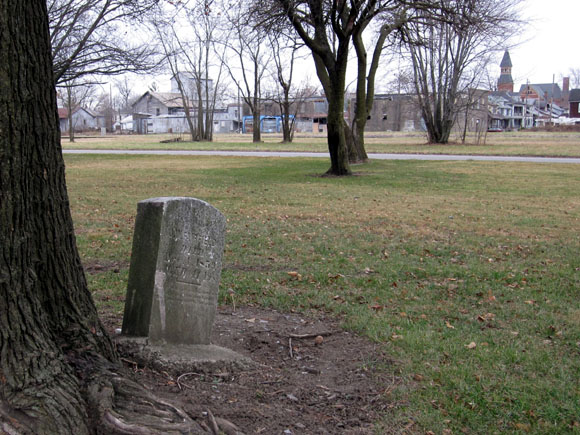
Paul J. Midlam did a survey of Marion County cemeteries back in the 1970s and 80s and published them in his book, Cemetery Inscriptions of Marion County, Ohio. He writes that the cemetery has gone by a few different names: the Old Marion Cemetery, Pioneer Cemetery and the Quarry Street Cemetery. As the city’s oldest graveyard, it’s also the final resting place of a number of historically significant people, including members of Eber Baker’s family as well as David Potts, a Revolutionary War veteran.
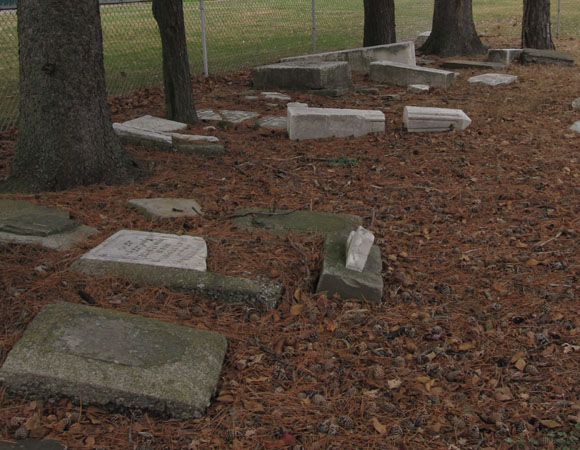
At first glance, the plot of land doesn’t look much like a cemetery. In fact, with its trees, the flag in the middle and its frequent use as a playground by neighborhood children, the cemetery almost resembles a park (albeit a boring one). Midlam offers a few reasons why the graveyard looks so un-graveyard like. First, the iron fence that once surrounded the property is long gone, and, more significantly, many of the tombstones are missing. (An interesting but unsubstantiated story around town is that the city removed many of the upright tombstones to make mowing the land easier. Supposedly, many of the stones are now buried beneath the hill in Lincoln Park, though why they should be there is anyone’s guess.) According to Midlam, vandals have destroyed a good number of the tombstones as well.
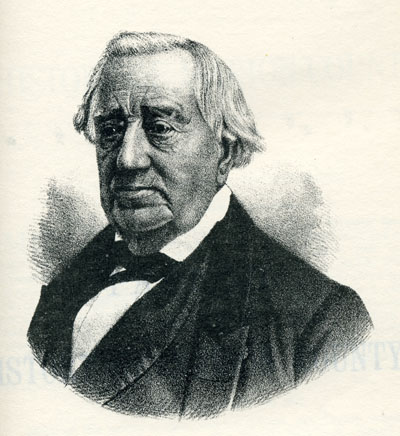
Perhaps the most macabre bit of history concerning the Old Cemetery is its role as the final resting place for many of the victims of a cholera epidemic that struck with terrifying swiftness during the summer of 1854.
Cholera, a bacterial infection that spreads through contaminated water and causes diarrhea, vomiting and cramps, was a serious public health concern during the 19th century. Today, thanks to antibiotics and modern water treatment systems, it has been virtually eliminated in the United States.
The Buckeye Eagle, one of Marion’s first newspapers, ran a story on July 20th, 1854, marking the appearance of cholera in Marion and calling it the “full scourge of mankind.” However, the paper was still relatively optimistic, as there had been, up till then, “but two or three cases, and these amongst the foreign (i.e. out of town) population.” Unfortunately for the residents of Marion, the epidemic was just the beginning.
A book titled The History of Marion County, Ohio states that after the epidemic began, “All business was suspended, and the streets were…desolate.” According to a book published in 1950 with the long-winded title Biographies of Many Residents of Marion County, Ohio and Review of the History of Marion County, “The plague lasted about six weeks, forcing terrorized residents to flee the village and killing sixty-five citizens. The bodies of the victims…are buried in the Old Cemetery.”
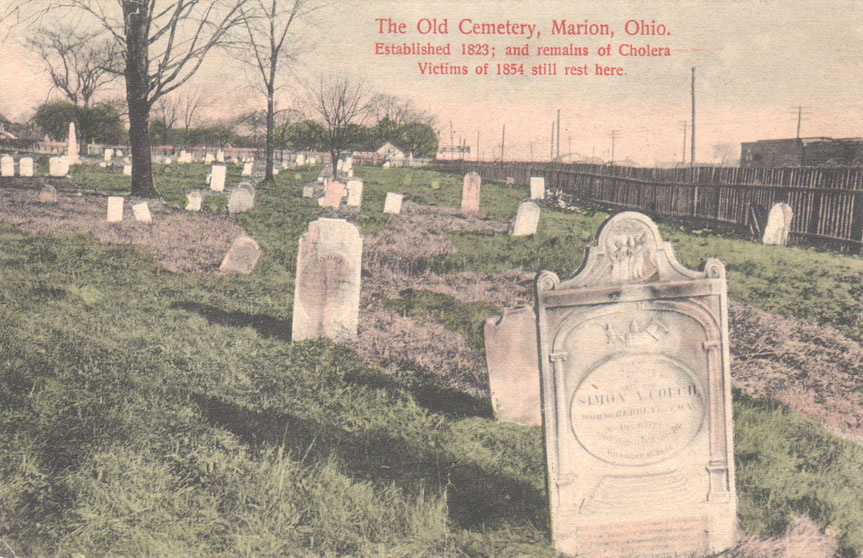
Bear in mind that the population of Marion at the time was just over 1300. That means that the epidemic killed one out of every twenty people in town and did so within the span of a few weeks. If a similarly deadly epidemic were to strike Marion today, it would kill approximately 1750 people.
After the epidemic many of the Quarry Street Cemetery’s vacant plots were suddenly occupied and this (along with noisy new rail lines across the street) hastened both the creation of the much larger Marion Cemetery a few years later and the subsequent decline, in both importance and upkeep, of the Quarry Street Cemetery.
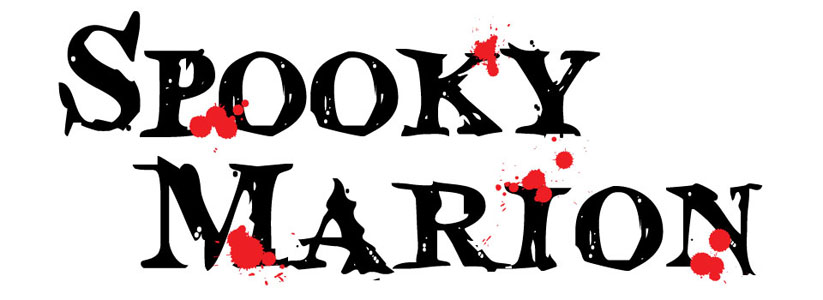
Trying to find some names of people who are buried and died from cholera. I have 4 relatives named Kopp from the 1850’s. Thanks for any info.
Years ago I heard there was a cemetery or some tombstones in the small wooded area west of Lincoln Hill but never investigated it. Also, this article mentions this is Marion’s oldest cemetery. I believe that Marion’s ‘first’ cemetery was located where the Marion water tower sits. This is a great website. Thanks.
You can find the first cemetery behind a home on Columbia St. On the corner of Columbia and Prospect. Go west one or 2 houses. Check the back yard. I remember seeing it years ago.
Hi Cindy, thanks for the info! Do you mean it’s in someone’s back yard? Are there any tombstones or other evidence that that’s where a cemetery was?
Yes. A brick home right by the alley west of S State.
I actually have seen it. Although it may be from a similar time period, back in those days it wasn’t uncommon for people to bury family in their own back yards as well as cemeteries
I grew up by Quarry St. and spent most of my days playing football and eating mullberrys in that graveyard, not to mention my first fights with many to come along with some more fun. Growing up we were told it was the black plague that had killed the people buried there.
I lived on Bellevue for a couple of years. My family would play ball in this cemetery. My two young girls and I would put the so few tombstones together as though they were a puzzle.
Looking for Samuel Poston’s grave. He may have lived in Marion. He was born 1793.
I used to leave flowers on the graves out of respect for the dead because so few cared about the headstones they were running on top of and the vandalism that had taken place. Being in a paranormal group, it was the most I could do to try and let those who have passed know that they are still being honored and in our memory. They were here long before us and had to lead more difficult lives than any of us could possibly understand. That cemetery definitely needs to be respected and needs a face lift. Stones need to be replaced and some put in to identify those who are in the ground that have no headstone.
One of the many persons rendering aid and comfort during the 1854 epidemic in Marion was Rev. Caspar H. Borgess, a visiting Catholic priest stationed in Columbus. In 1877 he wrote the following in a letter to his brother: “You accompanied your reverend brother on his sick calls to the hundreds of cholera patients in the city of Columbus, Ohio, in the three counties — Franklin, Delaware and Marion, Ohio. You saw the many sick of cholera on the railroads, in the farm-houses, in the cities — their alleys and lanes. The very recollection, the bare thought causes even now the blood to chill in my veins, for it brings to view the frightful writhings, the horrid convulsions, the maddening tortures, the black, agonies of the hundreds in the grip of death.
Growing up we were told that the Quarry Street cemetery was used as a “potters field” where the poor who died without any means were buried by the city. Not sure of that was ever true.
I did find another reference to the 1854 epidemic. Another Catholic priest, Father Thomas Sheahan also assisted in the 1854 cholera epidemic. The Catholic Telegraph reported on August 26, 1854: “During the late prevalence of the cholera in Marion, in this diocese, the panic was so great that the sick and dead were abandoned by their friends, and the Pastor in charge of that mission, Rev. Mr. Sheahan, had to coffin the dead, carry them in his buggy to the graveyard, and, in several instances, dig the grave himself.”
Rev. Sheahan was pastor of St. Patrick’s Parish in Bellefontaine and was also in charge of the mission in Marion.
My mother was from Marion, and told us that victims of the Spanish Influenza Epidemic in 1918 were buried there, and for that reason, to avoid unearthing the virus, no digging was allowed in the cemetery, and any monument foundations had to be shallow. Can anyone confirm this?
Any such virus would be gone by now. Virus only last for so long before they die off, and even if it were still around we have a cure for it now a days. The shallowing of headstones being placed isn’t so much intentional as much as it is the natural weather wearing the soil down. There are so many grave stone and plaques just sinking and falling over. Really it just depends on the stone, weight, placement and weather patterns
My brothers and I would cut through this graveyard on many occasions, stopping often to read the tombstones. It was the late 60s and some of those stones were still intact and legible. I can assure you we never saw a tombstone that was dated in the 20th century! In fact, most of them pre-dated the Civil War to my recollection.
As a kid in the 1980s, I always heard there was a circus elephant buried there. Rumor was, it died while the circus was in town and they buried it there. Has anyone else heard that?
My father told me that! I believe if the elephant did truly die; it would be somewhere near the train tracks though:
I walked through the cemetery on Quarry Street and I saw a headstone that read Abigail Mouse. It was in 1996 before my daughter was born. I named her Abigail. Now when I go there I can’t find her headstone.
The elephant is buried somewhere near the train tracks on west fairground street.